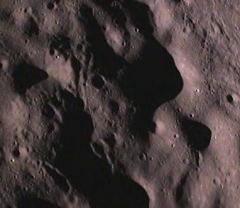Hitting a bull’s-eye on the Moon
I am in Bangalore, sitting awake in my hotel room at 4 am.

I am in Bangalore, sitting awake in my hotel room at 4 am. Last night was a memorable and exciting experience. Chandrayaan-1, in lunar orbit since last Saturday, released its Moon Impact Probe (MIP), designed to descend and hit the Moon at high velocity, sending images and other data as it went. This part of the mission had to go well in order to fully deploy the Chandrayaan antenna, required to send all the mapping data to Earth. Once the antenna is deployed tomorrow, Chandrayaan will begin the job of mapping the Moon from a polar orbit for the next two years.
What a great linked-together world we live in! As I sit here in India, in the middle of the night, on the opposite side of the Earth, my good friend Astronaut Don Pettit and six of his colleagues are getting ready to blast into orbit on the Space Shuttle Endeavour. I am watching the launch countdown on NASA TV over the internet on my laptop computer. In addition, I’m getting live launch status and weather reports via e-mail from my colleague Dr. Ben Bussey of the Applied Physics Laboratory, who is down at the Cape for the launch. Ben just sent me a Blackberry cell phone image he took of the Shuttle on the pad, lit up by floodlights; I reciprocated by sending him an image sent down last night from the Moon by the MIP just a few minutes before its impact. And just now, the NASA TV feed shows a nearly full Moon, slowly rising over the Atlantic and the Shuttle launch site. Three friends, separated by the globe and involved in two very different space missions, but looking over each others’ shoulders. I think about it and find it profound and deeply satisfying.
Back to the MIP impact last night. It has the air of a Hollywood premier about it. The press is packed along the street outside the Mission Control Center, the Chairman of the Indian Space Research Organization (ISRO) and the former President of India are in the viewing room, along with hundreds of ISRO engineers and scientists. The air is electric with anticipation. Although the mission of Chandrayaan has been nearly flawless so far, the release, descent and impact of the MIP is a critical event, not only for its data, but also for the pride India feels in this mission, all riding on a little subsatellite with the national flag painted on its side.
We have little to look at in the control center. Large computer projection displays show technical data and graphs. We observe major mission events by noting a change in velocity here or a drop in voltage there. I am somewhat lost, but one of the investigators on the MIP mass spectrometer helps me interpret what I’m seeing. The MIP separates from Chandrayaan, begins to spin for stabilization, and then fires a solid rocket motor to brake itself out of lunar orbit. The descent to the surface takes about 25 minutes. We see none of the data in real time; the images and measurements are being relayed to the main spacecraft and will be sent down to Earth in 90 minutes, on the next orbital pass. We see that everything is working fine through the cryptic and delightful expedient of observing Chandrayaan’s data recorder filling up – with numbers in hexadecimal, no less! – presumably with data from the probe. Suddenly, the graphs show a large spike or a drop to zero; the probe has hit the Moon! Applause and cheers!
There is much backslapping and good cheer in the room. President Abdul Kalam makes a brief and moving statement, dedicating the Moon probe to India’s children as a symbol of hope for the future. My colleague from APL and I decide that it’s been a long day and it’s best to leave the facility now; there’ll be plenty of time to look at the scientific results tomorrow. As we emerge from our cocoon, I am amazed to see the press frenzy outside. Long lines of reporters are doing TV remotes and newspaper people pace the sidewalk. They have been kept out of the control center and only a few are being let in for interviews. Therefore, anybody coming outside is fair game and they pounce on the two Americans (not particularly inconspicuous over here) for scraps of information. Who are we? Are we part of the mission? Was the probe impact successful? (This last question surprises me – haven’t they been told yet that all went well?) We try to answer their questions, but our car is waiting and the last thing we want is to get caught in the obviously approaching massive traffic jam. So we leap for the car doors and speed off into the night.
The MIP impact is a major public and media event. It is a source of great pride to the Indians and ISRO has done a marvelous job on the mission. But the real work is yet to come. In the next two years, Chandrayaan will map the Moon in unprecedented detail. Future milestones may be less splashy, but they will largely make up the ultimate value of the Chandryaan-1 mission.
/https://tf-cmsv2-smithsonianmag-media.s3.amazonaws.com/accounts/headshot/blog_headshot_spudis-300x300.jpg)
/https://tf-cmsv2-smithsonianmag-media.s3.amazonaws.com/accounts/headshot/blog_headshot_spudis-300x300.jpg)